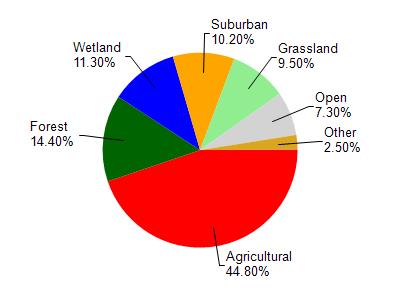Walworth
No
No
No
Fish and Aquatic Life
Overview
This shallow lake tends to be quite weedy. Managed for largemouth bass, panfish, and northern pike. Rough fish and stunted panfish populations were chemically eradicated in 1956, and desirable species were reintroduced. In addition to providing good fishing, waterfowl offer unusual opportunities for hunting and observation. The 570 acres of adjoining marsh and the vegetated nature of the lake itself afford optimum habitat for nesting and resting ducks. Unimproved road end access is provided for launching boats on the south shore and several unimproved sites are found on the north shore. There are 7 facilities renting boats and 4 of which also provide lodging and other conveniences. Como is nearing extinction; a control structure on Como Creek (4 foot head) maintains the water level for the present.
Source: 1961, Surface Water Resources of Walworth County,WI: WI-DNR Como Lake, T-2-N, R-17-E, Surface Acres = 1,058, S.D.F. = 1.75, Maximum Depth =8 feet.
Date 1961
Author Aquatic Biologist
Condition
Wisconsin has over 84,000 miles of streams, 15,000 lakes and milllions of acres of wetlands. Assessing the condition of this vast amount of water is challenging. The state's water monitoring program uses a media-based, cross-program approach to analyze water condition. An updated monitoring strategy (2015-2020) is now available. Compliance with Clean Water Act fishable, swimmable standards are located in the Executive Summary of Water Condition in 2018. See also the 'monitoring and projects' tab.
Reports
Recommendations
Habitat Restoration - Shoreland
Walworth County will continue the Walworth County Lakes Specialist position for one year. The Lakes Specialist will provide educational information to lake residents regarding shoreline stabilization and shoreline restoration. The Lakes Specialist will also design shoreline restoration projects for interested landowners, provide technical assistance to contractors and hold workshops on shoreland restoration.
Protect Riparian or Shorelands
Walworth County will implement the Shoreland Protection Initiative project that includes: 1. A baseline lakeshore inventory; 2. ten lakshore demonstration sites; 3. the preparation of lake lawn and yard nutrient management plans; 4. fact sheets on lakeshore stabilization, shoreland buffers, shoreland regulations and lawn care; 5. an annual lakeshore inventory and distribution of shoreland regulation materials; 6. formation of a Walworth Co. Lakes Association and meetings with and newsletter pertaining to Walworth Co. lakes; 7. Workshops, information packets and news articles pertaining to the Fox river Basin Partnership Team Lakes Initiative; and 8. the formation of the Walworth County Land Conservancy.
Management Goals
Wisconsin's Water Quality Standards provide qualitative and quantitative goals for waters that are protective of Fishable, Swimmable conditions [Learn more]. Waters that do not meet water quality standards are considered impaired and restoration actions are planned and carried out until the water is once again fishable and swimmable
Management goals can include creation or implementation of a Total Maximum Daily Load analysis, a Nine Key Element Plan, or other restoration work, education and outreach and more. If specific recommendations exist for this water, they will be displayed below online.
Monitoring
Monitoring the condition of a river, stream, or lake includes gathering physical, chemical, biological, and habitat data. Comprehensive studies often gather all these parameters in great detail, while lighter assessment events will involve sampling physical, chemical and biological data such as macroinvertebrates. Aquatic macroinvertebrates and fish communities integrate watershed or catchment condition, providing great insight into overall ecosystem health. Chemical and habitat parameters tell researchers more about human induced problems including contaminated runoff, point source dischargers, or habitat issues that foster or limit the potential of aquatic communities to thrive in a given area. Wisconsin's Water Monitoring Strategy was recenty updated.
Grants and Management Projects
Monitoring Projects
| WBIC | Official Waterbody Name | Station ID | Station Name | Earliest Fieldwork Date | Latest Fieldwork Date | View Station | View Data |
|---|
| 757900 | Como Lake | 653134 | Como Lake - Deep Hole | 7/21/1978 | 9/30/2011 | Map | Data |
| 757900 | Como Lake | 10006673 | Lake Como | 6/1/1997 | 7/12/2016 | Map | Data |
| 757900 | Como Lake | 10017634 | Lake Como -- Access at The End Of Schoefield Dr | 7/26/2009 | 7/16/2024 | Map | Data |
| 757900 | Como Lake | 10017635 | Lake Como -- Access Off Lakeshore Dr And Iris Rd | 7/5/2008 | 7/11/2009 | Map | Data |
| 757900 | Como Lake | 10045166 | Phragmites Occurrence - Como Lake | 7/15/2015 | 9/30/2017 | Map | Data |
| 757900 | Como Lake | 10059308 | Lake Como Dam Access | 7/25/2024 | 7/25/2024 | Map | Data |
| 757900 | Como Lake | 10017632 | Lake Como -- Access at S Shore Dr | 8/13/2006 | 8/5/2022 | Map | Data |
| 757900 | Como Lake | 10017633 | Lake Como -- Access Off Lakeshore Dr | 7/12/2007 | 7/16/2024 | Map | Data |
|

Watershed Characteristics
Como Lake is located in the White River and Nippersink Creek watershed which is 168.35 mi². Land use in the watershed is primarily agricultural (44.80%), forest (14.40%) and a mix of wetland (11.30%) and other uses (29.50%). This watershed has 239.00 stream miles, 8,603.24 lake acres and 10,838.84 wetland acres.
Nonpoint Source Characteristics
This watershed is ranked High for runoff impacts on streams, Medium for runoff impacts on lakes and High for runoff impacts on groundwater and therefore has an overall rank of High. This value can be used in ranking the watershed or individual waterbodies for grant funding under state and county programs.However, all waters are affected by diffuse pollutant sources regardless of initial water quality. Applications for specific runoff projects under state or county grant programs may be pursued. For more information, go to surface water program grants.